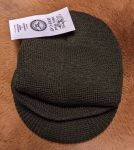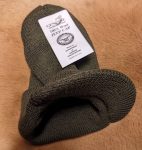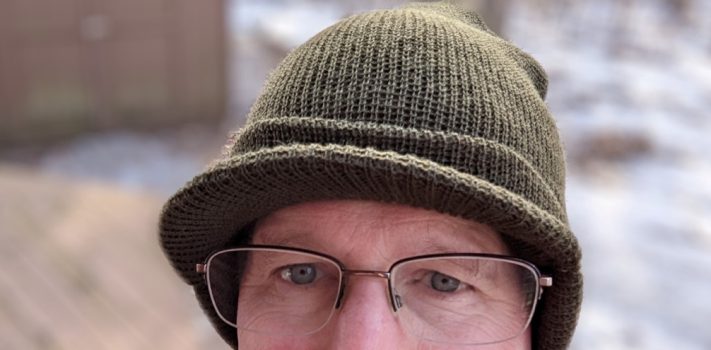Early in 2022, I acquired a Rothco 100% Wool Jeep Cap. I have worn it while walking the dog, stoking the outside wood boiler, clearing snow, and caring for other outside tasks. I have found it to be both warm and comfortable. The cap keeps my head and ears protected from the cold, while the visor protects my glasses from precipitation. It is made in the U.S.A. It has become my default headgear for winter outdoor work.
At the time of this writing, the cap was available from Rothco’s website for $11.99.
The Backstory
During warm weather, I typically wear a ball cap when I am working outside. The cap protects my bald spot from sunburn, and the visor protects my glasses from precipitation.
When more extensive exposure to sun or rain is expected, I typically wear a broad-brimmed hat. This provides additional protection from the elements for my ears and the back of my neck.
During cold weather, I used to wear a watch cap. It helped to keep my head and ears warm, but it did little to protect my glasses from falling snow or sleet.
A number of years ago, I found a jeep cap knock-off at a local thrift store. I snatched it up. The knit portion of the cap helped to keep my head and ears warm. The visor helped to protect my glasses. That jeep cap received a lot of heavy use over the years.
Because the knock-off cap was acrylic rather than wool, it was not quite as warm as I would have liked. I kept my eye out for a wool jeep cap in the local thrift stores, but I never found one.
Our church regularly sponsors blood drives in our community with two different organizations. One of the organizations supplies blood both to our small local hospital and to the large hospital in the closest metropolitan area. The other organization supplies blood to the medium-sized hospital in a nearby town. I am the church’s coordinator for these various drives.
Recently, one of the organizations gave me a gift card as a token of their thanks for my work as a drive coordinator. After due consideration, one of the things I purchased with the gift card was a wool jeep cap. A few days later, a package about the size and shape of a badly deformed softball arrived in the mail.
Opening the Package
The package shipped from “Go Commando Gear LLC” in Ronkonkoma, New York. The website listed on the package was “www.GruntForce.com”.
Inside the package, I found the jeep cap with a prominently placed tag proclaiming, “Genuine Government Issue 100% Wool Jeep Cap. Made to Department of Defense Specification. Made in U.S.A.”
 The label sewn inside the crown of the cap says, “Cap, Knit, Watch. (100% Wool). 8405-01 006-1074. RN 93084. Made in U.S.A.” The numbers on the label are quite interesting because, if my research is correct, the two numbers do not apply to the same cap. The first number seems to be the NATO stock number for a watch cap without a visor. The second number seems to be the US Army number for a jeep cap with a visor. An examination of some watch caps that are apparently made by the same company seems to suggest that the jeep caps are made by sewing a visor into the watch caps. Since a cap going through the manufacturing process may end up either as a watch cap or a jeep cap, both numbers are printed on the tag in the cap. If any SurvivalBlog readers serve in DoD procurement or otherwise have more expertise regarding this labeling, I would invite you to share your insights in the weekly snippets column.
The label sewn inside the crown of the cap says, “Cap, Knit, Watch. (100% Wool). 8405-01 006-1074. RN 93084. Made in U.S.A.” The numbers on the label are quite interesting because, if my research is correct, the two numbers do not apply to the same cap. The first number seems to be the NATO stock number for a watch cap without a visor. The second number seems to be the US Army number for a jeep cap with a visor. An examination of some watch caps that are apparently made by the same company seems to suggest that the jeep caps are made by sewing a visor into the watch caps. Since a cap going through the manufacturing process may end up either as a watch cap or a jeep cap, both numbers are printed on the tag in the cap. If any SurvivalBlog readers serve in DoD procurement or otherwise have more expertise regarding this labeling, I would invite you to share your insights in the weekly snippets column.
The Genuine Versus the Knockoff
 The genuine jeep cap is woven more loosely than the knockoff, with a yarn of greater elasticity. This makes it lighter, warmer, and more comfortable than the knockoff, although less wind-resistant. Even in the wind, it tends to keep the head warmer due to the superior insulating quality of wool yarn in contrast to acrylic. Combined with the hood of a garment like a Carhartt coat, the cap provides outstanding warmth.
The genuine jeep cap is woven more loosely than the knockoff, with a yarn of greater elasticity. This makes it lighter, warmer, and more comfortable than the knockoff, although less wind-resistant. Even in the wind, it tends to keep the head warmer due to the superior insulating quality of wool yarn in contrast to acrylic. Combined with the hood of a garment like a Carhartt coat, the cap provides outstanding warmth.
The greater elasticity of the yarn allows the genuine cap to fit a larger range of head sizes, and allows it to be pulled down lower over the ears for added warmth.
The crown of the genuine cap is taller than that of the knockoff. When the cap is worn high on the head not fully covering the ears, the extra material at the top of the cap can give it a somewhat conical and comical appearance. Since I wear the hat for comfort and not for style, this does not unduly distress me.
I found that the wool sometimes causes the back of my head or the nape of my neck to itch. It does not irritate any other area of skin like my ears, bald spot, or forehead.
Knit Cap History
Knitting seems to have originated in the Arab world by about 1100 AD. I speak of “knitting” in the broad sense. Experts disagree about whether or not “nålebinding”, made using a single needle, preceded true knitting, which is made using two needles. Since experts cannot always distinguish items made by the two techniques from each other, I will lump them together for the purposes of this article.
From the Middle East and North Africa, knitting spread to Europe and Asia. The advantage of knitting over weaving was that it did not require a loom. This made knitting a less expensive and more portable method of textile production than weaving.
As the practice of knitting spread to countries with cold weather climates, many of them independently developed various sorts of the knit caps. Whether the Danish “topplue”, the Welsh “Monmouth cap”, the Andean “chullo”, the Canadian “tuque”, or the “Balaclava” of the Crimean War, the various manifestations of the stocking cap kept heads warm in cold places around the world.
In many contexts, the stocking cap, particularly in the color red, became a symbol of liberty. This association originated with a conical felt hat, called the “pileus”, worn by freed slaves in ancient Rome. Over the course of time, the pileus became confused with the “Phrygian cap”, associated in antiquity with a number of people groups in Eastern Europe and Anatolia.
Because of this confusion of the Phyrgian cap with the pileus, in revolutionary France and America, Phrygian caps, particularly red Phrygian caps, came to be regarded as symbols of liberty. The similarity in appearance between Phrygian caps and many knit cap patterns caused the knit versions to be regarded as symbols of liberty as well.
As a result, in Norway during World War II, red knit caps came to be associated with opposition to the Nazi occupation. The association became so widespread that people were arrested by the Nazi and Quisling authorities simply for wearing red stocking caps.
These red stocking caps are called “nisseluer” or “Santa hats” in Norwegian. They are named after the red hats worn by barn spirits, who in Norwegian folklore are credited with delivering Christmas gifts. Because of the association of nisseluer with opposition to the Nazi occupation, postage stamps issued by the pro-Nazi Quisling regime in Norway pictured Santa Claus as wearing a green cap rather than the traditional red cap.
In the 20th century
The “jeep cap” or “beanie” was created when a visor was added to the traditional stocking cap during World War II. The first version of the jeep cap was issued by the US Army in February 1942 as the M1941 Wool Knit Cap. It was designed to be worn under a steel helmet to provide extra padding and warmth. It was such a practical and comfortable item of headgear, that it quickly became popular to wear without the addition of the steel helmet.
The original jeep cap has a six-stitch pattern at the crown of the cap. Later versions (like mine) have a four-stitch pattern.
Many officers, such as George Patton, felt that the jeep cap worn without a helmet produced a “slovenly” appearance. Patton forbade the troops under his command from wearing jeep caps in this way. He fined those who disregarded his command and confiscated their caps. I count this as one of the many character flaws exhibited by the great general.
Eventually, the jeep cap achieved iconic status. It has been worn in visual media by characters as diverse as Radar O’Reilly in the television series M.A.S.H. and Buddy’s brother Michael in the movie Elf. Radar wore the original M1941 jeep cap, while Michael wore a knock off, adorned with a Nike Swoosh.
Rothco History
In 1953, Milton Somberg began a used clothing and military surplus store called “Morris Rothenberg and Sons” in the Lower East Side of Manhattan. As supplies of military surplus dwindled, Rothco began manufacturing items that were no longer available on the surplus market. Rothco now claims to be the largest supplier in the United States of military, tactical, survival and outdoor products for the commercial market. With growth, they moved their operations from Manhattan to Brooklyn to Hauppauge on Long Island, and ultimately to Ronkonkoma, New York.
Conclusion
The Rothco 100% Wool Jeep Cap is a useful piece of winter headgear: warm, light, comfortable, and reasonably priced. It can be useful to people who spend a lot of time outside in cold weather, especially if they wear eyeglasses.
Disclaimer
I did not receive any other financial or other inducements to mention any vendor, product, or service in this article.










